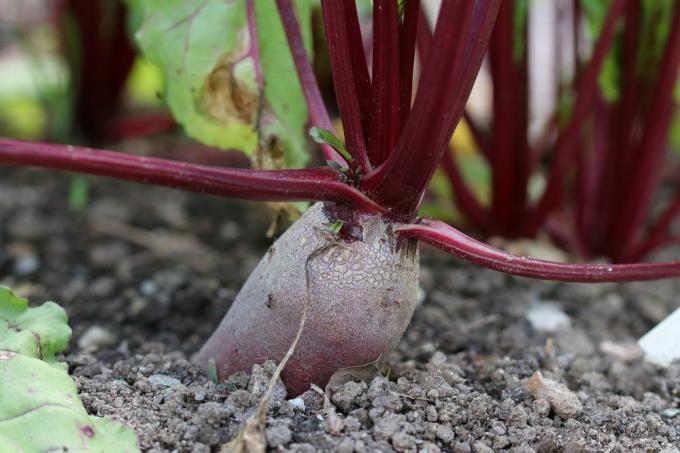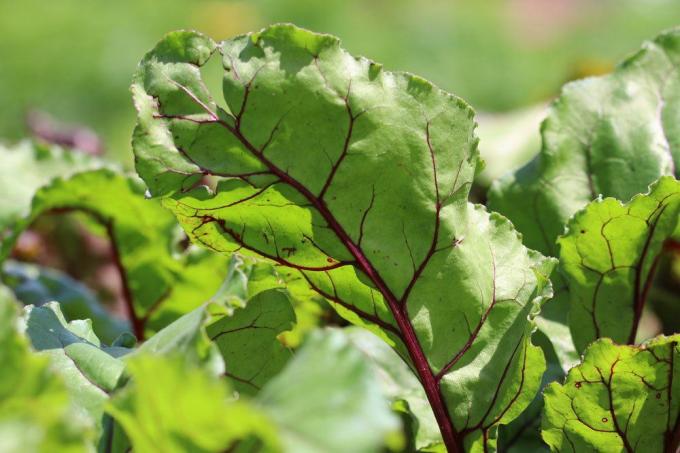
table of contents
- Best harvest time
- harvest
- Storage
- Basement room
- rent
The beetroot, which is related to the Swiss chard and also known as beetroot (different spelling beetroot) owes its name to the intensely purple-red tubers. These power bulbs are now available in different colors and fruit shapes. Typical of beetroot is the earthy and somewhat sweet taste, which is more or less pronounced depending on the time of harvest. With regard to the quality of the harvested fruit, the right timing plays a crucial role.
Best harvest time
By adhering to the crop rotation, you can influence the quality of the subsequent harvest or harvest while sowing. take the yield. Because it can protect against the colonization of harmful soil fungi. In addition, well-selected mixed cultures can have a positive effect on taste and aroma.
For example, mixed cultures with cabbage, lettuce, cucumber, beans, peas, fennel, lamb's lettuce, strawberries, dill or savory have proven themselves several times. In contrast, planting in the immediate vicinity of other tuber vegetables, potatoes, Swiss chard, spinach, leek, tomatoes and sweet corn should be avoided.
- correct harvest time depending on the respective variety and the time of sowing
- The main harvest time for beetroot is between July and October
- approx. 120-150 days
- Vegetables can be enjoyed at almost any stage regardless of the regular harvest time
- Tubers practically never really immature
- if sown early from around April, the red tubers are already ripe in summer
- Fruits from later sown, around June, can remain in the ground until the first frost
- Tubers that are fully ripe and fully grown, about the size of a tennis ball
- Beetroot harvested young as 'baby beets' is particularly tender and aromatic
Yields that result from early sowing before June are not suitable for storage, they would become too large too soon. The bigger and older the tubers get, the more water they store and the more aroma is lost. Harvest time is over at the latest with the very first frost and the beetroot has to be fetched from the earth. These small tubers tolerate temperatures of a maximum of minus 3 degrees.

Tip: Not only the tubers but also the young leaves can be harvested and eaten, they contain about six times as much vitamin C as the tubers. However, they should not be larger than 10 cm, because only then are they still tender and contain only a little oxalic acid. It goes without saying that not all leaves must be cut off, because this is the only way the tubers can continue to grow and become ripe. At least the heart leaves should stay on the tuber.
harvest
How is it harvested?
A sunny day should be chosen for harvesting these vegetables. Even if you don't have to worry about consuming these fruits unripe, frequent consumption can lead to increased nitrate pollution. In order to keep this as low as possible, the time of day at which the harvest takes place is crucial. If the harvest takes place in the late afternoon, the nitrate content in the tubers is lowest. As a rule, it only becomes problematic with regular and frequent consumption of beetroot.
- Not only is proper timing important, careful harvesting practices are also important
- Tubers must not be injured in the process
- The slightest damage could quickly lead to rot
- It is best to use a digging fork for harvesting
- so that the tubers are lifted slightly in the morning but not pulled out yet
- only get out of the ground in the late afternoon or early evening

Tip: The coloring agent contained in the beetroot has an intense coloring power. Therefore one should pay attention to appropriate clothing when handling these fruits. The red color usually sticks to the hands for a few days.
Storage
Storable beets are usually harvested in October. Baby tubers harvested in summer cannot be stored; they should be eaten quickly. The beetroot, freshly pulled from the ground, should never be washed before storing. In addition, storage that is too warm and humid should be avoided, as it could lead to increased nitrate or Lead to nitrite pollution.
A cool and dark cellar with comparatively high humidity is ideal for storage. If there is no cellar, a so-called rent, which you can make yourself relatively easily, also does.
Basement room
These vegetables can be kept for several weeks in a cool and dark cellar. Before storing it, the herb is turned off. In no case should it be cut off, otherwise the tubers would bleed out. Then you carefully wipe off the loose earth with your hands. Do not knock the earth, this would damage the fruit.

Now you take a standard wooden box and line it with foil. Then you fill it about halfway with damp sand. Spread the beets on the sand and cover them again with a layer of sand. If necessary, the tubers can be stored in several layers on top of each other. However, they shouldn't be touching. The higher the humidity in the basement, the less water the tubers lose, provided it is cool.
rent
A so-called rent, as it is often used to store potatoes, carrots or other root vegetables, is also suitable for storing beetroot. For a corresponding rent you first choose a small spot in the garden, if possible not so far from the house. Then a pit about 60 x 60 cm wide and deep is excavated.
To protect them from voles and other rodents, they are then clad with a close-meshed grid or wire mesh, both the bottom of the pit and the walls. As an alternative, solid materials such as B. Formwork boards are used. Now a 10 cm thick layer of sand is placed on the bottom of the earth pile, on which the beets are then distributed. Here, too, the tubers should not touch.

Depending on how many you want to store, they can be stacked accordingly. There must always be a sufficiently thick layer of sand between each layer of tubers. A layer of straw forms the end and the excavated earth is spread over it. If necessary, the whole thing can also be covered with boards. In frost-free weather, the rent should be opened and ventilated occasionally. Smaller amounts of these purple-colored tubers can also be preserved very well by freezing them or soaking them in vinegar.



